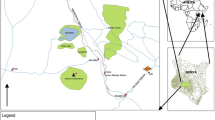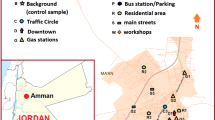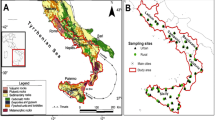Abstract
A soil survey was carried out to determine the levels and sources and concentrations of 16 polycyclic aromatic hydrocarbons in 2 semi-rural terrains in Mexico City (Tlahuac and Milpa Alta) during 2008–2009. PAH determination was made by Soxhlet extraction and chromatographic clean-up with final analysis by gas chromatography with a flame ionization detector. The concentrations in Tlahuac were 9.13 mg/kg (dry season) and 11.22 mg/kg (wet season) and in Milpa Alta were 11.43 mg/kg (dry season) and 35.77 mg/kg (wet season). The variation of total PAH concentrations are due to environmental and anthropogenic conditions within Mexico City and also the addition of compost to the soils. According to Mexican regulations BaP, DaA, BbF and Ind were within the permissible limit (2 mg/kg) for agricultural and residential soils and BkF was close to the limit (8 mg/kg). The total PAH concentrations do however surpass the permissible European limit of 1,000 μg/kg and there is probably some risk to human health, in spite of measures aimed at decreasing contamination in Mexico City. Long term monitoring of soils will be necessary.
Similar content being viewed by others
Explore related subjects
Discover the latest articles, news and stories from top researchers in related subjects.Avoid common mistakes on your manuscript.
Polycyclic aromatic hydrocarbons (PAHs) are compounds with two or more aromatic rings (benzene) produced by both natural and anthropogenic pathways although anthropogenic activities generally release much greater amounts to the environment (Eom et al. 2007). They originate from combustion, coke production, oil derivates and high temperature industrial processes. PAHs are considered as persistent organic pollutants (POPs) according to the Stockholm Convention. In many studies of contamination, they have been found in air, water, food and soil. There is evidence that some PAHs are carcinogenic, mutagenic and toxic. Monitoring of the PAHs in the environment is important in the evaluation of risk to the health of organisms (Maher and Aislabie 1992).
Soils are large reservoirs of hazardous contaminants derived from anthropogenic activities. Some studies of wet and dry atmospheric deposition of PAHs have found values of >10 mg/kg, mainly in urban soils and tropical areas, for example in Brazil (Krauss et al. 2000; Wilcke 2000). Soils are contaminated with PAHs mainly from atmospheric deposition from stationary sources (gas burning, industrial and municipal organic residues incineration, forest fires) and mobile sources (mainly from fuel fossil combustion for terrestrial transportation) (Mastral and Callen 2000). Soil contamination by PAHs is considered to be a good indicator of the level of environmental pollution by human activities (Chung et al. 2008). PAHs from soil and water are possibly dangerous to human health because plant root uptake can result in bioconcentration (Samsoe et al. 2002).
Some research has suggested that growth of urban areas near agricultural land has consequences for inorganic and organic contamination of natural resources (air, soils, water, crops) by indirect and direct exposition (Wang et al. 2009). Mexico City has different contamination problems that affect the quality of life of population (Escobedo et al. 2000) related to the increase in vehicular traffic, waste combustion and industrial activities. Mexico City’s government has encouraged sustainable agricultural activities in more rural areas and considers that agricultural land should be protected from further urban growth in order to support the recharge of the aquifer under the city as well as for growing important crops such as maize, flowers, vegetables and fruit trees (GDF 2003; Grupo Produce 2006).
This research was conducted in Tlahuac (situated in south-east Mexico City) at a mean altitude of 2,500 m mean, an area in the temperate region of Mexico. Rain falls almost exclusively between June and August with a mean precipitation of 534 mm. Mean monthly maximum temperatures range from 14°C in January to 22.8°C in May. The study site was composed mainly of grassland and pine forest. Milpa Alta (also situated in south-east Mexico City) is the second largest delegation of the Federal District by surface area. It is a mountainous area with a mean altitude of 2,500 m and is in a cold temperate region. Rainfall is abundant and the mean temperature is 14°C. The principal vegetation is trees, mainly different species of pine. Typically in the rurally populated hills, slopes have a 15% gradient although slopes of 25% gradient also are quite common. The main objective of this study was to determine concentration of PAHs in top soils of rural terrains and the probable source of this contamination in dry and wet months.
Materials and Methods
We collected a composite sample (1 kg) of soil for each location from an area of approximately 1,500 m2 during both dry and wet months. The samples were conserved in amber glass bottles in order to avoid possible contamination by traffic and other sources during transportation and were then stored frozen at −5°C. The soil samples were sieved through 2-mm mesh after removing stones, residual roots and unwanted materials, then homogenized and after sealed in aluminium foil and kept in the refrigerator prior to analysis for PAHs. Samples (5 g) were mixed with anhydrous sodium sulfate and Soxhlet extracted using a solvent mix of hexane-dichloromethane (1:1). Extraction time was 8 h after which the organic extracts were evaporated in a rotary evaporator to 5 mL (Samsoe et al. 2002). Chromatographic columns were prepared with silica gel and aluminium oxide deactivated with deionized water (5%) and topped with anhydrous sodium sulfate. The samples were passed through the columns then the PAHs eluted with a mixture of hexanedichloromethane (9:1 and 1:1). The organic extract was concentrated in a rotary evaporator to 1 mL and transferred to a vial for gas chromatographic analysis according to EPA method 8100 (EPA 1986).
The concentrations and profiles of PAH compounds were analyzed using a Perkin Elmer AutoSystem gas chromatograph (Column HP-5, 30 m, 0.35 mm ID, 0.25 lm film thickness). The oven temperature was initially set at 90°C and held for 0 min then ramped at 8°C/min to 180°C (held for 1 min), then ramped at 5°C/min to 245°C, and ramped at 2°C/min to a final temperature of 300°C. Detector and injector temperature were 320°C. The carrier gas was high purity helium (99.99%). A sample of 1 μL was injected in splitless mode.
Identification of PAH compounds were based on matching their retention time with a mixture of PAH standards (Chem Service). The 16 PAH compounds were naphthalene (Nap), acenaphthylene (Acy), acenaphthene (Ace), fluorine (Flu), phenanthrene (Phe), anthracene (Ant), fluoranthene (Fla), pyrene (Pyr), benzo(a)fluorene (BaF), benzo(a)anthracene (BaA), chrysene (Cry), benzo(b)fluoranthene (BbF), benzo(k)fluoranthene (BkF), indeno(1,2,3-cd)pyrene (Ind), dibenzo(ah + ac)anthracene (DaA), and benzo(ghi)perylene (Bghi). The detection limits were 0.01 mg/kg for most compounds.
Quality control was made by analysis of fortified blanks and samples together with the performance of the GC. Recoveries were 80%–90% except for naphthalene for which a value of 50% was obtained. Quantification of individual PAHs was made by an external standard method.
Results and Discussion
The results show that in the wet season total concentration of PAHs was higher at both sites (Tlahuac 11.27 mg/kg and Milpa Alta 35.77 mg/kg) in comparison to the dry season (9.13 mg/kg and 11.43 mg/kg respectively; Table 1). These high concentrations are probably due to wet deposition that “cleans” the atmosphere of city in the rainy season. The high concentrations in the Tlahuac area in both seasons could be attributed to a nearby mine for construction materials that employed heavy machinery for extraction and transportation of the material. In Milpa Alta there was increased PAH concentrations in the wet season, probably due to the direction of wind from north to south during the rainy season. The generally high concentrations in the Milpa Alta soil are probably caused by air deposition of contaminants by the prevalent north to south wind.
The most consistently present carcinogenic PAH was BaP, which is considered the most hazardous of all. It was detected at an average concentration of 1.67 mg/kg in the samples analyzed, greater than the concentrations found in soils from China (1.1 mg/kg) for example (Cai et al. 2007).
The distributions of PAHs according to the number aromatic rings is shown in Table 2. In the Tlahuac area there are approximately equal concentrations of intermediate and high molecular weight compounds, while in the Milpa Alta area there is a higher percentage of intermediate compounds,
Figure 1 shows the distribution of individual PAHs in top soils where the dominant compounds were Cry, BaA, BaP, Fla and Bghi. This implies that the high contamination of the soil is due to anthropogenic activities such as combustion (fossil fuels, vegetation and domestic waste), industrial emissions and use of household chemicals products.
The high levels of BaP in the soils is an indication of both pyrogenic and petrogenic sources of PAH pollution on the environment (Essumang et al. 2011). These concentrations in both seasons were considered within permissible limits (2 mg/kg) for agricultural and residential land use according to Mexican regulation NOM 138-SEMARNAT/SS-2003. However, the levels of BaP surpassed the limit established by the Danish Environmental Protection Agency (0.1 mg/kg) and Canadian Council of Ministers of the Environment (0.26 mg/kg; Essumang et al. 2011). The BaP concentrations are considered to be a risk to human health due to potential exposure to carcinogenic PAHs for those living in those areas.
Concentrations of DaA, BaA, BbF, BkF and Ind were lower than the permissible limit for agricultural land use according NOM-138-SEMARNAT/SS-2003 (2 mg/kg). These compounds do not represent a risk for human health in comparison to BaP.
The presence of Fla and Bghi in the two areas may indicate a common vehicular emission source that is relatively large (García-Alonso et al. 2003).
We applied diagnostic ratios previously reported in the literature to identify the probable source of contamination and we found mixed sources for the two areas of Mexico City. Influences from the most common PAH sources (industrial and transport) were evident. The PAH atmospheric dispersion was greater in areas with heavy vehicular activity, and there was a high level of PAH deposition in roadside soils.
Combustion derived PAHs (pyrogenic) usually contain high molecular weight (HMW-PAHs) which are abundantly generated at high temperature, while the petroleum—derived residues (petrogenic) contain a relatively high abundance of low molecular weight PAHs (LMW-PAHs).
A value of Ind/(Ind + Bghi) > 0.5 indicates grass/coal/wood combustion sources. Values of Fla/(Fla + Pyr) < 0.4 indicate pyrogenic sources, and values 0.4–0.5 indicate fuel combustion and >0.5 suggests grass/coal/wood combustion sources. The ratio of BaP/Bghi is used as an indicator for the determination of traffic and non-traffic sources; values >0.6 are characteristic of traffic sources (Yin et al. 2008). Values of Ant/(Ant + Phe) < 0.1 and BaA/(BaA + Cry) < 0.2 correspond to petrogenic sources; values >0.1 and >0.35 respectively, indicate pyrogenic sources. A ratio of BaA/(BaA + Cry) between 0.20 and 0.35 indicates mixed petrogenic and pyrogenic sources while ratios of BkF/Bghi and BaP/Bghi with values of 1.2–5.0 indicate wood and coal burning (Wang et al. 2009) (Table 3).
According to Essumang et al. (2011) the total PAH values were high (above 1,000 μg/kg) and they considered 5-ring PAH concentrations above 200 μg/kg in soils to be high concentrations. The values of total PAHs for Mexico City were classified as severely polluted (>1,000 μg/kg) in relation to European agricultural soils. In Europe the highest PAH concentrations ever reported occurred in the soils in urban areas of Estonia and ranged from 2,200 to 12,300 μg/kg.
In these terrains there is addition of compost and manure every year and organic matter and moisture content in soil are factors that impact on availability of organic contaminants. The PAHs will be strongly bound by the soil where there are high organic matter contents and so not so easily taken up in crops and trees (Zohair et al. 2006; Ping et al. 2007). Lighter molecular weight PAHs are easily degraded, although their presence is due to the frequent and incomplete combustion of wood or coal (Ping et al. 2007).
The great variations of contamination in soils are due to industrialization, heating, and automotive traffic, and are affected by soil depth and type of land use. Also in agricultural soils consideration must be given to the effect of the addition of sewage sludge, farmyard manure, compost or composted waste sewage sludge mixtures to the terrains in Mexico City (Cai et al. 2007).
The presence of PAHs in soils has been found to be increasing in industrial and urban developments over the last few decades. Some studies have indicated that vehicle exhausts are major sources of PAHs in soils along with increased use of wastewater for irrigation of crops. The contamination in Mexico City is high due to the environmental conditions, for example high population density and geography (such as altitude and temperature), where atmospheric deposition (diffuse and point sources) leads to high concentrations of PAHs. Similar contamination situations have been reported in Chinese soils (Ping et al. 2007).
The increase in urbanization in Mexico City will lead to higher PAH pollution levels, and the health implications have received little attention by the regulatory authorities and decision makers. Generally, rapid industrialization and urbanization leads to deterioration of environmental quality (Cai et al. 2007). With increasing pollution, it is expected that there will be a long term impact on vegetable production and quality.
The results obtained from this study clearly demonstrate that influences from different PAHs sources (fossil fuel and vegetation combustion) are evident. The average concentration of PAHs in the soil ranged from 9.13 to 35.77 mg/kg for the analyzed soils. The diagnostic ratios indicated distinct mixed combustion sources. This contamination will be an ongoing issue as PAHs are persistent, and human exposure by inhalation of particles, dietary intake of contaminated food products such as vegetables, and direct contact with polluted soils will continue.
References
Cai QY, Mo CH, Li YH, Zeng QY, Katsoyiannis A, Wu QT, Férard JF (2007) Occurrence and assessment of polycyclic aromatic hydrocarbons in soils from vegetable fields of the Pearl River Delta, South China. Chemosphere 68:159–168
Chung NJ, Cho JY, Park SW, Hwang SA, Park TL (2008) Polycyclic aromatic hydrocarbons in soils and crops after irrigation of wastewater discharged from domestic sewage treatment plants. Bull Environ Contam Toxicol 81:124–127
Eom IC, Rast C, Veber AM, Vasseur P (2007) Ecotoxicity of a polycyclic aromatic hydrocarbon (PAH)-contaminated soil. Ecotoxicol Environ Saf 67:190–205
EPA (Environmental Protection Agency-US) (1986) Method 8100 Polynuclear aromatic hydrocarbons. Revision 0. September. 10 pp
Escobedo JF, Victoria AR, Ramírez A (2000) La problemática ambiental en la Ciudad de México generada por las fuentes fijas. Secretaría del Medio Ambiente. 14 pp
Essumang DK, Kowalski K, Sogaard EG (2011) Levels, distribution and source characterization of polycyclic aromatic hydrocarbons (PAHs) in topsoils and roadside soils in Esbjerg, Denmark. Bull Environ Contam Toxicol 86:438–443
García-Alonso S, Pérez-Pasto RM, Sevillano-Cataño ML (2003) Occurrence of PCBs and PAHs in an urban soil of Madrid (Spain). Toxicol Environ Chem 85:193–202
GDF (2003) Programa general de ordenamiento ecológico del Distrito Federal. Available via http://www.sma.df.gob.mx/sma/index.php?opcion=26&id=61. Accessed 11 March 2009
Grupo Produce DF (2006) Aportes en marcha. Available vía http://www.grupoproducedf.org.mx/aportes.htm. Accessed 11 March 2008
Krauss M, Wilcke W, Zech W (2000) Polycyclic aromatic hydrocarbons and polychlorinated byphenyls in forest soils: depth distribution as indicator of different fate. Environ Pollut 110:79–88
Maher WA, Aislabie J (1992) Polycyclic aromatic hydrocarbons in near shore marine sediments of Australia. Sci Total Environ 112:143–164
Mastral A, Callen MS (2000) A review on polycyclic aromatic hydrocarbon (PAH) emissions from energy generation. Environ Sci Technol 34:3051–3056
NOM-138-SEMARNAT/SS-2003 (2003) Límites máximos permisibles de hidrocarburos en suelos y las especificaciones para su caracterización y remediación. Diario Oficial de la Federación 25/Marzo/2005. 21 pp
Ping LF, Luo YM, Zhang HB, Li QB, Wu LH (2007) Distribution of polycyclic hydrocarbons in thirty typical soil profiles in the Yangtze River Delta region, east China. Environ Pollut 147:358–365
Samsoe LP, Larsen EH, Larsen PB, Bruun P (2002) Uptake of trace elements and PAHs by fruit and vegetables from contaminated soils. Environ Sci Technol 36:3057–3063
Wang K, Shen Y, Zhang S, Ye Y, Shen Q, Hu J, Wang X (2009) Application of spatial analysis and multivariate analysis techniques in distribution and source study of polycyclic aromatic hydrocarbons in the topsoil of Beijing, China. Environ Geol 56:1041–1050
Wilcke W (2000) Polycyclic aromatic hydrocarbons (PAHs) in soil—a review. J Plant Nutr Soil Sci 163:229–248
Yin ChQ, Jiang X, Yang XL, Bian YR, Wang F (2008) Polycyclic aromatic hydrocarbons in soils in the vicinity of Nanjing, China. Chemosphere 73:389–394
Zohair A, Salim AS, Soyibo AA, Beck AJ (2006) Residues of polycyclic aromatic hydrocarbons (PAHs) polychlorinated biphenyls (PCBs) and organochlorine pesticides in organically-farmed vegetables. Chemosphere 63:541–553
Acknowledgments
This work was supported by the Metropolitan Autonomous University ‘‘Xochimilco’’ Campus. We thankful to Eduardo Villegas in his labour in laboratory and the producers that helped with your terrains in Tlahuac and Milpa Alta for good development of this research.
Author information
Authors and Affiliations
Corresponding author
Rights and permissions
About this article
Cite this article
Ortiz, R., Vega, S., Gutiérrez, R. et al. Presence of Polycyclic Aromatic Hydrocarbons (PAHs) in Top Soils from Rural Terrains in Mexico City. Bull Environ Contam Toxicol 88, 428–432 (2012). https://doi.org/10.1007/s00128-011-0434-5
Received:
Accepted:
Published:
Issue Date:
DOI: https://doi.org/10.1007/s00128-011-0434-5





